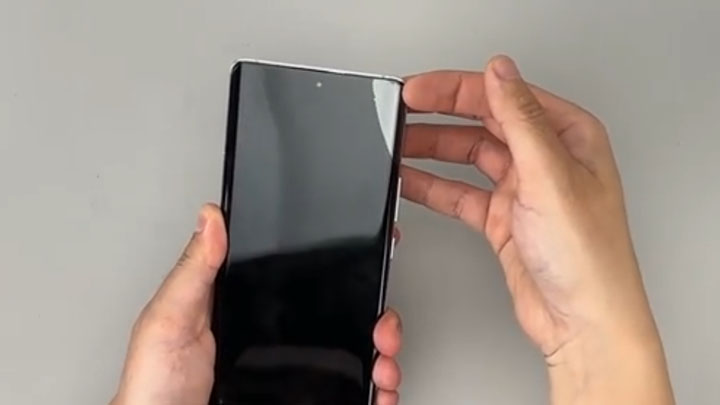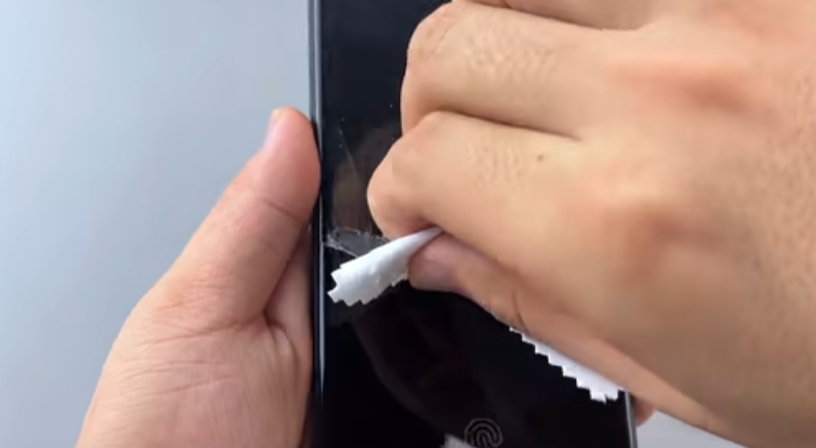UV screen protectors are popular for their high transparency, strong adhesion, and scratch resistance. Due to their specialized adhesive, they're considered one of the best screen protectors for curved phones.
However, the UV-curable adhesive of UV screen protector forms a robust bond, making removal challenging without damaging your device's screen. This tutorial provides step-by-step guidance on safely removing a UV screen protector from devices. With patience and the right tools, you can complete the process without professional help!
Preparation
Before starting, gather the necessary tools and materials to ensure a smooth and safe removal process.
Tools and Materials Needed
Plastic pry tool or thin plastic card to lift the screen protector without scratching the screen.
Isopropyl alcohol or adhesive remover, for cleaning residual adhesive.
Microfiber cloth for cleaning the screen and keeping it dust-free.
Fine nylon thread or dental floss to cut through the adhesive layer and separate the protector.
Gloves will prevent your from hurting yourself and avoid fingerprints or oil smudges on the screen.
Preparation Tips:Please power off the mobile phone and work in a clean environment,and protect yourself— the tempered glass may shatter into sharp pieces. Wear gloves or have transparent tape ready to handle fragments.
Removal Steps
Since UV-curable adhesive is not heat-sensitive, removal relies on mechanical separation and chemical cleaning. Follow these detailed steps:
Step 1: Find an Entry Point
Inspect the edges: Examine the screen protector’s corners or edges for any small gaps or lifted areas.
Attach a small suction cup to a corner of the screen protector (near the edge) and gently pull to create an entry point.
If the suction cup doesn’t stick, try different corners or gently use a fingernail to lift an edge.
If no edge is lifted, carefully insert a plastic pry tool (or plastic card) into a corner, applying gentle pressure to lift a small section.

Caution: Work slowly to avoid scratching the screen. If lifting is difficult, try Step 2’s thread method.
Step 2: Separate the Screen Protector
Choose one of the following methods based on the entry point created:
Method 1: Direct Peeling
Grip the lifted corner of the screen protector with your fingers or tweezers,but proceed with caution.
Slowly pull the protector at a 30-45-degree angle, using steady, even force to avoid tearing or cracking it.
If you encounter strong resistance, pause and switch to Method 2 or try a different corner.
Method 2: Using Nylon Thread or Dental Floss
Take a 20-30 cm piece of fine nylon thread or dental floss and hold it taut at both ends.
Insert the thread into the gap between the screen protector and the screen, then gently move it back and forth in a sawing motion to cut through the adhesive.
Keep the thread tight and work along the protector’s edge, advancing slowly until the protector is fully separated.
Tip: For tempered glass UV protectors, which are rigid and prone to cracking, the thread method is preferred to avoid shattering.

Step 3: Remove Residual Adhesive
UV-curable adhesive may leave sticky residue on the screen, requiring careful cleaning:
Dampen a microfiber cloth with high-concentration isopropyl alcohol or adhesive remover and gently wipe the residual adhesive.
For stubborn residue, apply a small amount of alcohol to the adhesive, let it sit for 1-2 minutes to soften, then wipe again.
If alcohol doesn’t fully remove the residue, press transparent tape onto the sticky areas and peel it off repeatedly to lift small adhesive particles.
If available, shine a UV light on the screen to detect any remaining adhesive (some UV-curable adhesives fluoresce under UV light).
If residue is found, repeat the alcohol or tape cleaning process.
Step 4: Clean the Screen
Dampen a clean microfiber cloth with a small amount of isopropyl alcohol or a dedicated screen cleaner and gently wipe the entire screen to remove any remaining adhesive, fingerprints, or smudges.
Wipe the screen again with a dry microfiber cloth to ensure it’s dry and streak-free.
Inspect the screen under bright light or with a magnifying glass to confirm it’s free of residue, scratches, or damage.
Tip: If minor scratches are visible, consider using a screen polishing compound for light repairs. For deep scratches, consult a professional repair service.
Important Notes
Be gentle:
UV-curable adhesive is extremely strong. Avoid forceful pulling to prevent screen damage or protector breakage.
Avoid metal tools
Metal tools (e.g., knives) can scratch the screen. Always use plastic pry tools or cards.
Handle fragments carefully
If the protector is tempered glass and cracks, apply transparent tape to secure fragments and remove them as a whole to avoid injury or screen scratches.
Use chemicals safely
Apply alcohol or adhesive remover sparingly to avoid seepage into device gaps.
Common Questions and Answers
Q1: What if I can’t lift the screen protector at all?
A: Try using a suction cup on different corners or use a nylon thread to cut through the adhesive from multiple angles. If it remains stuck, consult a professional repair service to avoid damaging the screen.
Q2: What if the adhesive residue won’t come off with alcohol?
A: Use a commercial adhesive remover (e.g., Goo Gone) or apply a small amount of olive oil to soften the residue, then wipe with alcohol. Always clean thoroughly afterward to remove any oil.
Q3: What if the screen gets scratched during removal?
A: Minor scratches can be treated with a screen polishing compound applied with a microfiber cloth. For deeper scratches, contact the device manufacturer or a professional repair service.
Aftercare and Recommendations
After removal, check for any adhesive residue, scratches, or damage. Address issues promptly with cleaning or professional help.
Choose a good new protector: If replacing the protector, Consider a better quality screen protector. In order to save costs, low-quality UV screen protectors may use low-quality UV glue, which makes it very difficult to remove.
High-quality screen protectors do not have such a problem and are easy to remove, so please use a better quality screen protector when purchasing.



